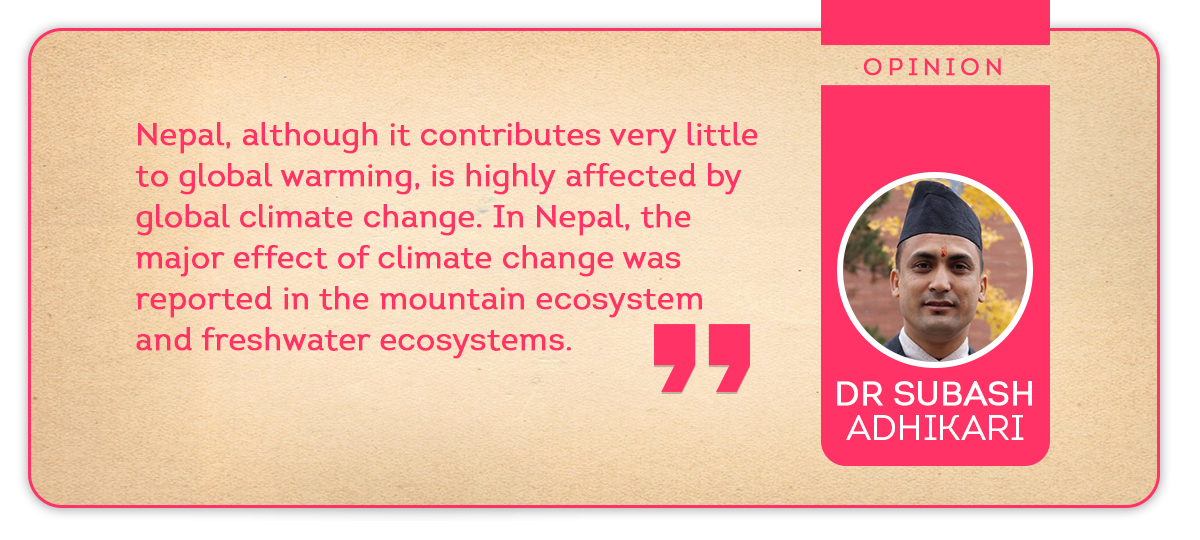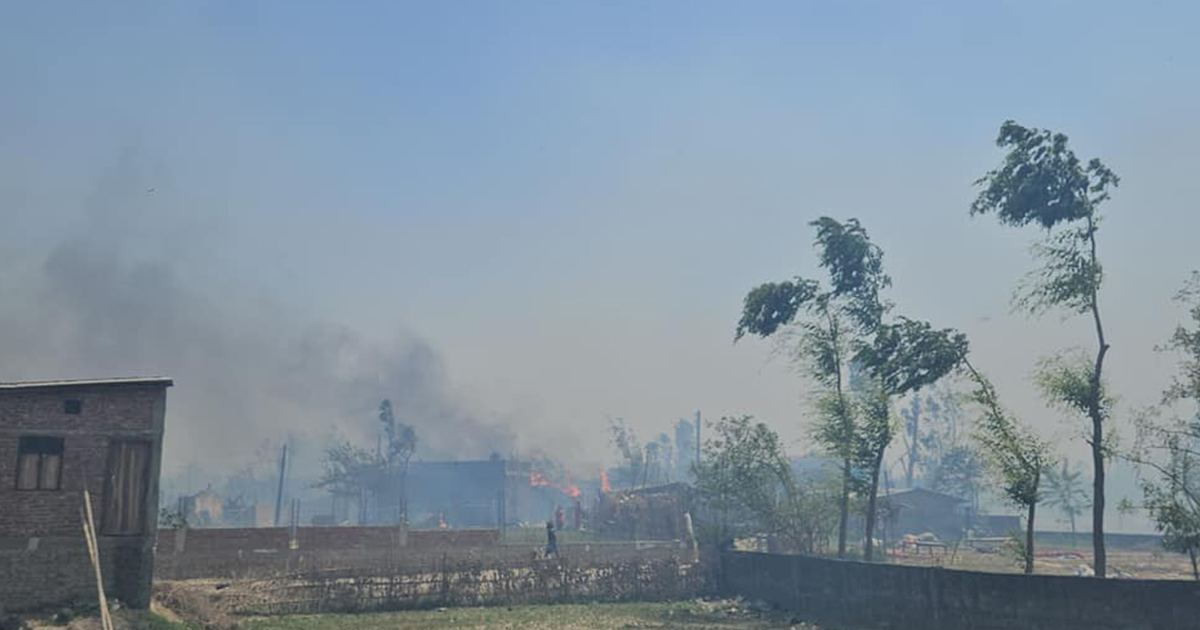
OR
Climate Change Impact on Nepal’s Central Himalayas: A Scientific Outlook
Published On: June 24, 2021 12:50 PM NPT By: Dr Subash Adhikari


Dr Subash Adhikari
The author is a member of the Policy and Planning Commission, Gandaki Province, Nepal.news@myrepublica.com
Nepal, although it contributes very little to global warming, is highly affected by global climate change. In Nepal, the major effect of climate change was reported in the mountain ecosystem and freshwater ecosystems.Introduction
Climate change denotes the alteration in earth’s global or regional climate over an extended period, either due to natural inconsistency or as a consequence of anthropogenic activities. It is caused due to exponential development of CO2 and other greenhouse gases (GHGs) in the atmosphere. Major gases that play a vital role in global warming are water vapor, carbon dioxide (CO2), methane (CH4), nitrous oxide (N2O), and chlorofluorocarbons (CFCs). It is a change in the statistical distribution of weather patterns for decades to millions of years and direct drivers of ecosystem changes. Scientists have been actively working to understand past and future climate by using observations and theoretical models as it is the most emerging and challenging issue for scientists worldwide. The influence of climate change is one of the serious issues.
Climate change perspective in Nepal
Warming of about 0.2°C per decade for the next two decades is projected in the world. The Intergovernmental Panel on Climate Change (IPCC) also predicted that the temperature will increase by 2.4°C to 6.4°C by the end of the 21st century. The study reported at least 0.6 ⁰C per decade warming in the Himalayas that is already three times higher than the prediction by IPCC for the coming decades. The temperature in the Himalayan region has been stated to be increasing more rapidly than the global average. The maximum temperature in Nepal increased at a rate of 0.06 °C per year between 1978 and 1994, with higher rates at higher elevations.The Himalayan region is not only prone to rapid warming but also is strongly influenced by regional and long-range transport of pollutants influencing snow albedo. The fourth assessment report of the IPCC also projected a severe impact of climate change on mountain ecosystems. As compared to the lower elevation, global climate change is found to occur rapidly in higher elevations. Higher (about 1°C per 160 m) than with latitude. Subsequently, the trans-Himalayan region is estimated to experience a hasty fluctuation in its ecosystem which will have a large impact on natural phenomenon, livelihood, and vegetation resources.
Effects on terrestrial ecosystem
a.Land cover change
A study in Mustang uncovered that grassland and forest decreased drastically and barren land increased dramatically due to climate change (increase in temperature and decrease in precipitation. Both global climate change and anthropogenic pressure are contributors to the land cover change in the central Himalayas, Nepal.
b.Treeline shifting in the Nepal Himalayas
The shifting of treeline toward a higher elevation above its existing range in the Lower Mustang region (observation of the younger Betula utilis and Abies spp. tree species <10 years old). Another study reported that lower elevation species have expanded to higher elevations resulting in a change in community composition. However, soil types, water resources act as limiting factors in the process of shifting the species toward a higher elevation. If such a mechanism continues rapidly, associated species are highly vulnerable to extinction and the former site needs to be replaced by new species. Another related study also revealed the temporal upward shifting of Abies spectabilis, 80m higher in between 1850-2012. The average upward movement of the upper distribution limit of A. spectabilis at the study sites was calculated to be 2.61 m year−1 (1.56– 3.66 m year−1). A recent study also reported the retreating in the Gangapurna and Annapurna III glaciers in the Manang valley, central Nepal, resulted in forest advancement over the past 200 years.
c.Change in plant phenology
Climate change has altered plant phenology in the Himalayas. Decreases in the length of the dry season have altered the timing of leaf flush, flowering, reproduction of Rhododendron, and also the activities of flower-visiting animals which ultimately alters the balance between the ecosystem in the respective area. Shifts in the onset and length of growing seasons are also associated with changes in temperature and rainfall patterns and amounts. Local people observed early flowering, sprouting, and fruiting in some plants around the Mustang region, Central Himalayas.
d.Loss of biodiversity and recklessness of wild animals
New alien and invasive species are emerging and their habitat is spreading at a faster rate. The consequence of the migration of the forest toward the higher altitude is a change in their composition, and extinction of species. Species may respond to climate change either by adapting, shifting their range, changing their abundance, or disappearing. Extreme climatic conditions have led to increased incidence of fire and lead to species and habitat loss which leads to the loss of biodiversity, the most significant aspect to show the adverse effect of climate change on the ecosystem. Due to extreme environmental conditions, the migration of birds toward safe areas has been observed. Tropical evergreen forests are the reservoir for many wild animals, reptiles, and birds like one-horned rhinos, tigers, deer, snakes, and birds. Climate change induced loss of forest area impacts negatively on these wild animals resulting in the extinction of species year by year. Snow leopards (already listed as endangered on the IUCN Red List) and Blue Sheep are residents of high altitudes, love snow, and are very sensitive to increasing temperature and previously they were not encountered by humans living in that area. But due to the rapid melting of snow in that area, these organisms have shifted toward the human settlement areas and are creating a problem for the local people. Human-driven habitat reduction and fragmentation have been observed for decades. In the whole of the country from 1978/79 to 1994/95, forest area has decreased at an annual rate of 1.7 %, whereas forest and shrub together have decreased at an annual rate of 0.5 % - all resulting in the loss of habitats of plants and animals. Some species such as Crocodyluspalustris, Kachugakachuga, and Gavialisgangeticus have very poor dispersal capacity and their habitat is a wetland in the Terai region of Nepal. Shrinkage of wetland areas already triggered the extinction of those faunas.
e. Imbalance in carbon sequestration
At normal environmental conditions, the forest is a major component of the carbon cycle as trees can sequester carbon in organic form thus reducing CO2 emission. It has been estimated that the forest ecosystem can sequester 20-100 times more carbon than that of cropland. The study reported high uncertainty regarding carbon sequestration in the forests of Nepal. Emission of CO2 by anthropogenic activities like land-use change, deforestation, and conversion to agricultural land in the Hindu Kush Region resulting in soil erosion, loss of organic carbon in the soil which ultimately alters soil fertility. A high incidence of forest fire was also reported in this region which leads to declining sequestered carbon. This mechanism is also proliferating global climate change.
Effects on freshwater ecosystem
The aquatic ecosystem includes freshwater ecosystems and marine ecosystems. Nepal only harbors a freshwater ecosystem as it is a land-locked country. Freshwater ecosystems are the most vulnerable type of ecosystems in the world and are very sensitive to climate change. More than half of wetlands in the world are altered although they are biologically rich and play major roles in providing ecosystem services to a greater magnitude.
Nepal is a rich country in water resources and to date, 10 sites are listed as wetland. Each of them harbors flora and fauna. As glacier fed-rivers are the sources for most of the water bodies in Nepal, the modification in the flow regime alters the ecological diversity and function of river systems as well as disrupts sediment flux and thermal regime. A distribution list of 76 indigenous cold-water fish has been observed in Nepal that love the clean river and cold water and Rara Lake is famous for three types of endemic fishes. Some species of fish are already designated as endangered which may be either by the increase in temperature or by the addition of toxic substances and fertilizers from agricultural land.
Others
a. Agriculture and food security
In Nepal, more than 80% of the population relies on agriculture as a source of food, employment, and income. More than 70% of Nepal’s agriculture is rain-fed. The largest share of total crop production comes from the central region (nearly one‐third), followed by the eastern and western regions. The agricultural system is highly sensitive to change in temperature, precipitation, natural disasters, and abnormal weather conditions. Rice is a major crop of Nepal and its production depends on summer precipitation and rice production has decreased these days due to insufficient precipitation and summer drought. The decrease in the paddy and wheat yields is due to a change in rainfall pattern and increase in winter drought, respectively. Increased impacts from various insects, pests and fungal infections triggered by the increase in temperature were noticed in rice, potato, and millet, thereby reducing total production was also found in Dolakha district. The temporal and spatial pattern of drought phenomenon in Gandaki River Basin, the basin with the highest amount of precipitation in Nepal, reported the serious effect of drought on rain-fed agriculture. They detected lesser yields of major crops like paddy, rice, wheat, maize in drought years as compared to normal years. Overall, under a doubled CO2 scenario predicted for 2100, rice yield in Nepal is expected to drop by about 4.2 % relative to current production levels. According to FAO, all people have the right to consume safe food. As domestic food production declines due to abnormal weather conditions like drought, hailstone, and storm, a huge amount of food needs to be imported. Recently, high food insecurity has been observed in Nepal.
b. Human health
Human health is also affected by climate change. Some examples suggest climate change has already resulted in the introduction of infectious diseases into previously unaffected geographic areas in Nepal. Water-borne diseases like typhoid, cholera, diarrhea etc have increased due to inadequate drinking water especially in the summer (May-September). Apart from this, climate change further helps most of the vector-borne diseases like malaria, kala-azar, dengue, plague, etc to emerge. Cardiovascular diseases, physiological stress, and malnutrition are also found to be associated with climate change in Nepal.
c. Water-related hazards
Water-related hazards triggered by global warming and melting of glaciers are not only being the cause of death and poverty in human society but also are being a driver for the significant loss of large areas of land along with its respective bio-diversities. Glacier lake outburst flood upstream and flood along with landslides downstream was reported from eastern part of Nepal i.e.,Koshi River Basin which is a direct driver of ecosystem loss. Similarly, climate change triggered a loss in drinking water resources and displaced a whole village from its former site to a new place. This process alters the balance of the existing ecosystem in the shifted area.
Summary
Nepal, although it contributes very little to global warming, is highly affected by global climate change. In Nepal, the major effect of climate change was reported in the mountain ecosystem and freshwater ecosystems. Treeline shifting, change in land cover, extinction of species due to loss of habitat, imbalance in carbon sequestration were reported in the terrestrial ecosystem while eutrophication of water bodies and extinction of endemic fish species was reported in the aquatic ecosystem. Climate change-induced natural disasters and health impacts especially in Tropical areas were reported. Microbes play a major role in all types of ecosystems balancing the natural phenomenon. However, no studies have been conducted in Nepal related to the impact of climate change on microbes and their role in biogeochemical cycles i.e. Carbon, Nitrogen, Phosphorous, and Sulphur cycles. Microbes are changing climate and have been changing climate for decades so they should not be excluded while studying the impact of climate change. Moreover, different types of ecological modeling can be simulated in the context of Nepal for the prediction and future analysis of the impacts of climate change. Therefore, ecological modeling-based research works should be emphasized in Nepal.
You May Like This

Trade, climate change, Iran focus as G-20 leaders meet
OSAKA, June 27: Trade and geopolitical tensions, and the looming threat of climate change, are on the agenda as the... Read More...

Students globally protest warming, pleading for their future
WASHINGTON, March 16: Students across a warming globe pleaded for their lives, future and planet Friday, demanding tough action on... Read More...

As unusual drought hits eastern Nepal, farmers migrate to get by
AANGNA, Oct 10: Ravi Ale has worked the family’s two hectares of land in eastern Nepal since he was old... Read More...





Just In
- World Malaria Day: Foreign returnees more susceptible to the vector-borne disease
- MoEST seeks EC’s help in identifying teachers linked to political parties
- 70 community and national forests affected by fire in Parbat till Wednesday
- NEPSE loses 3.24 points, while daily turnover inclines to Rs 2.36 billion
- Pak Embassy awards scholarships to 180 Nepali students
- President Paudel approves mobilization of army personnel for by-elections security
- Bhajang and Ilam by-elections: 69 polling stations classified as ‘highly sensitive’
- Karnali CM Kandel secures vote of confidence














Leave A Comment